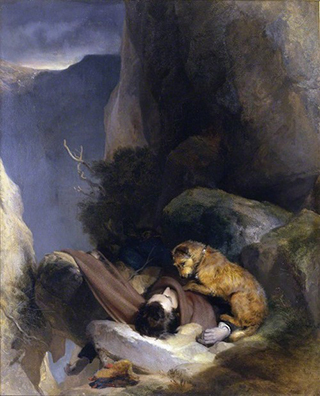Fidelity is one of William Wordsworth's less known poems about a shepherd being led to the body of a young artist by the artist's faithful dog. The young man met his demise on Helvellyn Mountain near Grasmere in the Lake District.
In 1805, Charles Gough, a former Quaker - it's interesting that at the age of twenty-one he had time to be a former anything - had ventured from Patterdale to Grasmere with nothing more than his dog and his painting equipment, but suffered a tragic accident that cost his life. Three months later, his dog led a local shepherd to the body. The incident became immortalised in the poems by William Wordsworth and Sir Walter Scott, and in the paintings of Sir Edwin Landseer and others.
So what has any of this got to do with West Indian immigrants to the UK? Well, firstly, it was one of the many classic poems taught to school pupils at the Vielle Case Government School in northern Dominica, as my cousin Sylvia LeBlanc, who is a teacher in neighbouring Penville, recounted.
Secondly, as you will see from the painting, it's ilustrative of how history becomes sanitised and romanticised. Reality is often omitted, and replaced by a rose-tinted retrospective, which for many is far more palatable.
Thirdly, it comes at a time in which inhabitants of the Caribbean are becoming increasingly aware of having art and literature imposed upon them from afar, when in fact they had a literary heritage of their own in authors such as Jean Rhys and many more. Dominica's literary heritage is catalogued in Dr. Irving André's Distant Voices.
Finally, it touches upon the prospect that the protagonist, Tio Mourillon, similar to the artist, has perhaps ventured too far away from a place of familiarity and safety.
 Fidelity by William Wordsworth
Fidelity by William Wordsworth
A barking sound the shepherd hears,
A cry as of a dog or fox;
He halts, and searches with his eyes
Among the scattered rocks:
And now at distance can discern
A stirring in a brake of fern;
And instantly a dog is seen
Glancing from that covert green.
The dog is not of mountain breed;
Its motions, too, are wild and shy;
With something, as the shepherd thinks,
Unusual in its cry:
Nor is there any one in sight
All round, in hollow or on height;
Nor shout, nor whistle strikes his ear:
What is the creature doing here?
It was a cove, a huge recess,
That keeps till June December’s snow;
A lofty precipice in front,
A silent tarn below!
Far in the bosom of Helvellyn,
Remote from public road or dwelling,
Pathway, or cultivated land,
From trace of human foot or hand.
There sometimes doth a leaping fish
Send through the tarn a lonely cheer;
The crags repeat the ravens’ croak
In symphony austere;
Thither the rainbow comes—the cloud—
And mists that spread the flying shroud;
And sunbeams: and the sounding blast,
That, if it could, would hurry past,
But that enormous barrier binds it fast.
Not free from boding thoughts, a while
The shepherd stood; then makes his way
Towards the dog, o’er rocks and stones,
As quickly as he may;
Nor far had gone before he found
A human skeleton on the ground:
The appalled discoverer with a sigh
Looks round, to learn the history.
From those abrupt and perilous rocks
The man had fallen, that place of fear!
At length upon the shepherd’s mind
It breaks, and all is clear:
He instantly recalled the name,
And who he was, and whence he came;
Remembered, too, the very day
On which the traveller passed this way.
But hear a wonder, for whose sake
This lamentable tale I tell!
A lasting monument of words
This wonder merits well.
The dog, which still was hovering nigh,
Repeating the same timid cry,
This dog had been through three months’ space
A dweller in that savage place.
Yes, proof was plain that since the day
On which the traveller thus had died
The dog had watched about the spot,
Or by his master’s side:
How nourished here through such long time
He knows, who gave that love sublime,
And gave that strength of feeling, great
Above all human estimate.